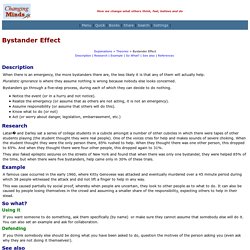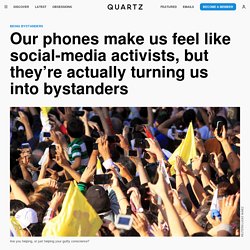

Bystander Apathy Experiment - The Case of Kitty Genovese Explained. (127) The Bystander Effect: Why Some People Act and Others Don't. The Bystander Effect. Ethics Defined: Diffusion of Responsibility. Diffusion of Responsibility: Definition, Theory. The Smoke Filled Room Experiment. The smoke filled room study. How the Social Context Influences Helping – Principles of Social Psychology – 1st International Edition. Review Bibb Latané and John Darley’s model of helping behavior and indicate the social psychological variables that influence each stage.
Although emotional responses such as guilt, personal distress, and empathy are important determinants of altruism, it is the social situation itself—the people around us when we are deciding whether or not to help—that has perhaps the most important influence on whether and when we help. Consider the unusual case of the killing of 28-year-old Katherine “Kitty” Genovese in New York City at about 3:00 a.m. on March 13, 1964.
Her attacker, Winston Moseley, stabbed and sexually assaulted her within a few yards of her apartment building in the borough of Queens. During the struggle with her assailant, Kitty screamed, “Oh my God! He stabbed me! The Bystander Effect and Altruism. Learning Objectives Explain the factors that influence human altruism, including reciprocal altruism and diffusion of responsibility.

Go to YouTube and search for episodes of “Primetime: What Would You Do?” You will find video segments in which apparently innocent individuals are victimized, while onlookers typically fail to intervene. The events are all staged, but they are very real to the bystanders on the scene. The entertainment offered is the nature of the bystanders’ responses, and viewers are outraged when bystanders fail to intervene.
Figure 1. When Do People Help? Social psychologists began trying to answer this question following the unfortunate murder of Kitty Genovese in 1964 (Dovidio, Piliavin, Schroeder, & Penner, 2006; Penner, Dovidio, Piliavin, & Schroeder, 2005). More recently, in 2010, Hugo Alfredo Tale-Yax was stabbed when he apparently tried to intervene in an argument between a man and woman. Bystander Effect. Explanations > Theories > Bystander Effect Description | Research | Example | So What?

| See also | References Description When there is an emergency, the more bystanders there are, the less likely it is that any of them will actually help. Pluralistic ignorance is where they assume nothing is wrong because nobody else looks concerned. Bystanders go through a five-step process, during each of which they can decide to do nothing. The bystander effect is being made worse by people filming violent events on their smartphones. On April 9, 2017, a video of a man being dragged off a United Airlines flight was posted on the internet and went viral.

But I don’t need to tell you that. Each of your most outspoken Facebook friends probably posted about the event, highlighting the aspects of it that best reinforced their worldview. The incident was covered all over American media and even sparked outrage in China. The collective focus may have now moved on to its next source of outrage, but there was something that only a few people noticed in the moment: a plane full of quiet passengers. Other than one woman screaming, hardly anyone else on the plane seemed bothered enough by what was happening to raise a ruckus. Instead of intervening in the assault, the passengers stoically took out their cameraphones and pointed them toward David Dao, whose body was dragged along the aisle of the airplane, glasses askew, face bloody, and belly exposed.
How you can help. Ripple Effect. 5 Effective Tips to Overcome the Bystander Effect. What is the Bystander Effect and How Can We Overcome it? - DefibsPlus. You may think that you are more likely to receive life-saving care if you experience a Sudden Cardiac Arrest (SCA) in a crowd or busy area – but the opposite is actually true.

This is due to the bystander effect; a natural phenomenon where the greater the number of bystanders, the less likely any individual is going to act to provide help. It’s a complex phenomenon but one we actively need to combat in order to support people in distress. Helping Kids Overcome the Bystander Effect. Newscasters love to share stories of kids as young as three years old calling 911 to save a parent’s life.

These stories bear out what research has shown us: Very young children have a propensity to be kind and helpful. Starting as early as 18 months, studies show, toddlers spontaneously help an adult who is unable to pick up something he dropped or finds himself in a similarly tricky situation. Being kind at a cost to themselves makes two year olds happy, and three year olds who cooperate on a task share rewards even when they don’t have to. But a recent study suggests that, like adults, kids are also subject to a major obstacle to helping: the bystander effect. That’s when being part of a group paralyzes people from coming to the aid of someone in need—a phenomenon well documented by social psychologists. In this study, five year olds were coloring pictures when they witnessed an adult “accidentally” spill colored water all over her desk. But there was a twist. Explicit teaching.